Communication Styles and Barriers: Enhancing Professional Interactions
VerifiedAdded on 2023/06/15
|8
|2030
|315
Essay
AI Summary
This essay provides an overview of communication, defining it as the exchange of information between individuals and exploring various communication methods such as verbal, written, non-verbal, and visual. It identifies communication barriers, including semantic, psychological, organizational, and personal barriers, which impede effective communication. The essay highlights the importance of understanding different communication styles—passive, aggressive, passive-aggressive, and assertive—and emphasizes the necessity of overcoming barriers to enhance coordination, decision-making, and relationships. It also offers practical recommendations for improving communication, such as ensuring clarity, acknowledging emotional responses, using simple language, and fostering a non-judgmental environment, to promote a positive and efficient working atmosphere. Desklib provides this essay and other resources to aid students in their studies.
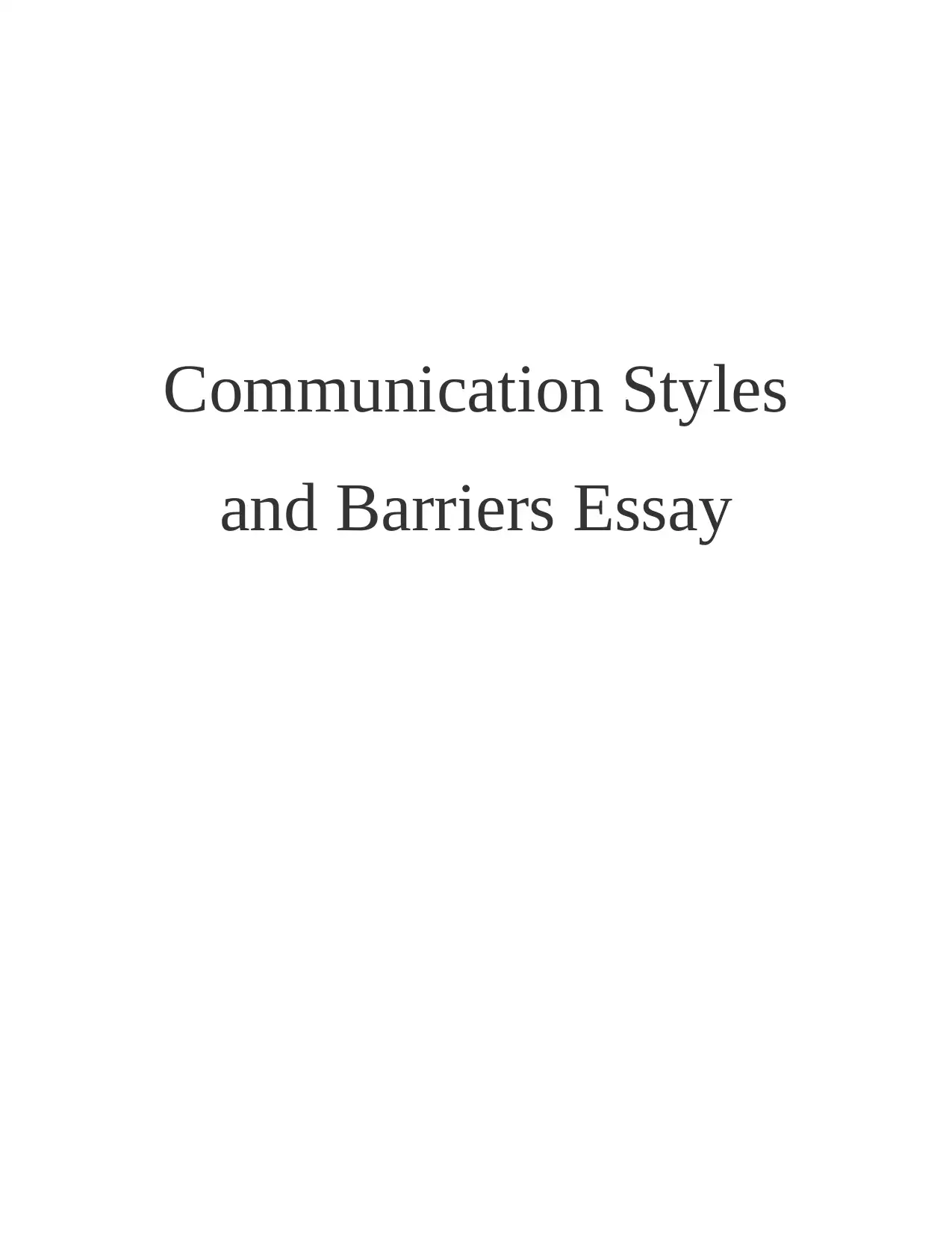
Communication Styles
and Barriers Essay
and Barriers Essay
Paraphrase This Document
Need a fresh take? Get an instant paraphrase of this document with our AI Paraphraser
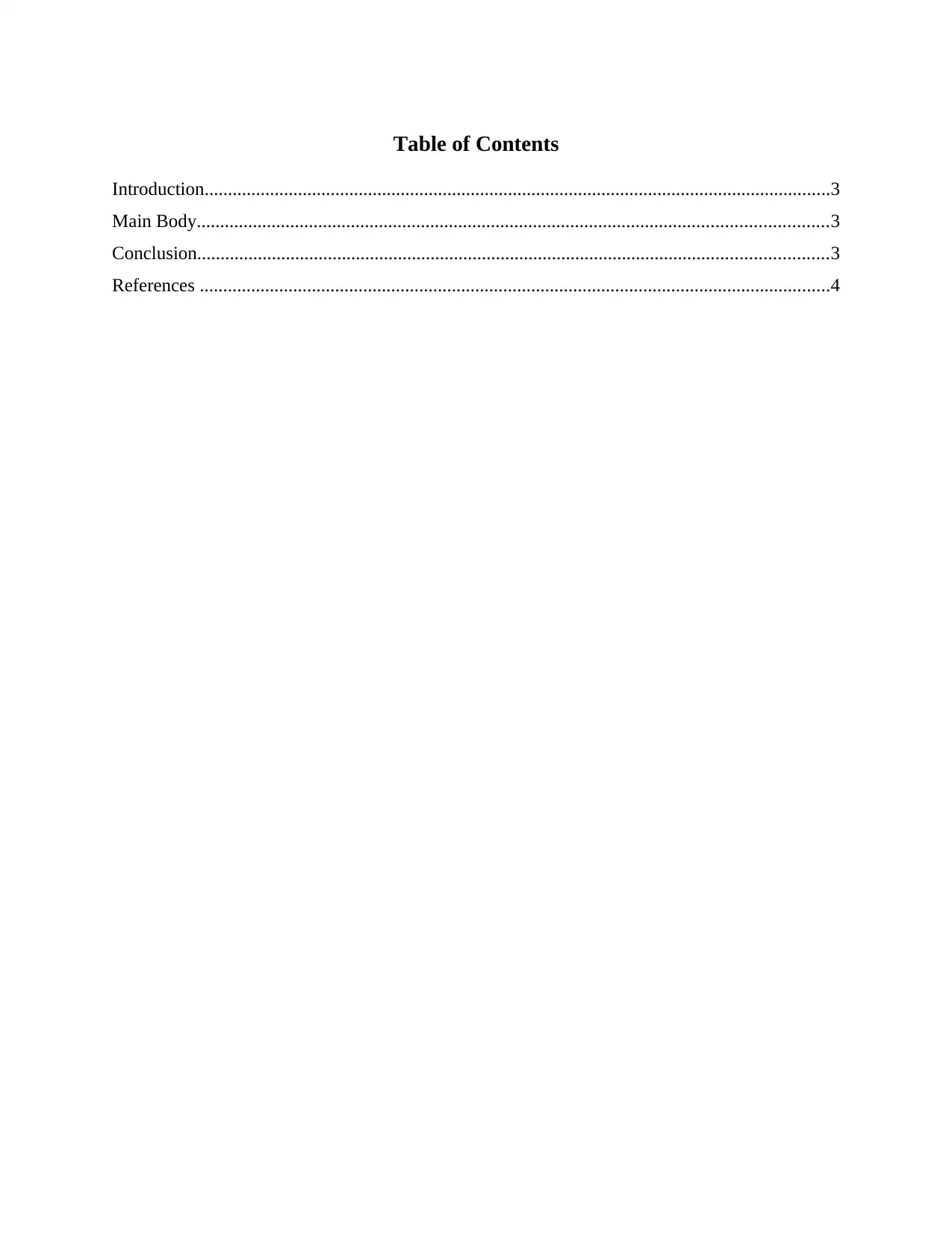
Table of Contents
Introduction......................................................................................................................................3
Main Body.......................................................................................................................................3
Conclusion.......................................................................................................................................3
References .......................................................................................................................................4
Introduction......................................................................................................................................3
Main Body.......................................................................................................................................3
Conclusion.......................................................................................................................................3
References .......................................................................................................................................4
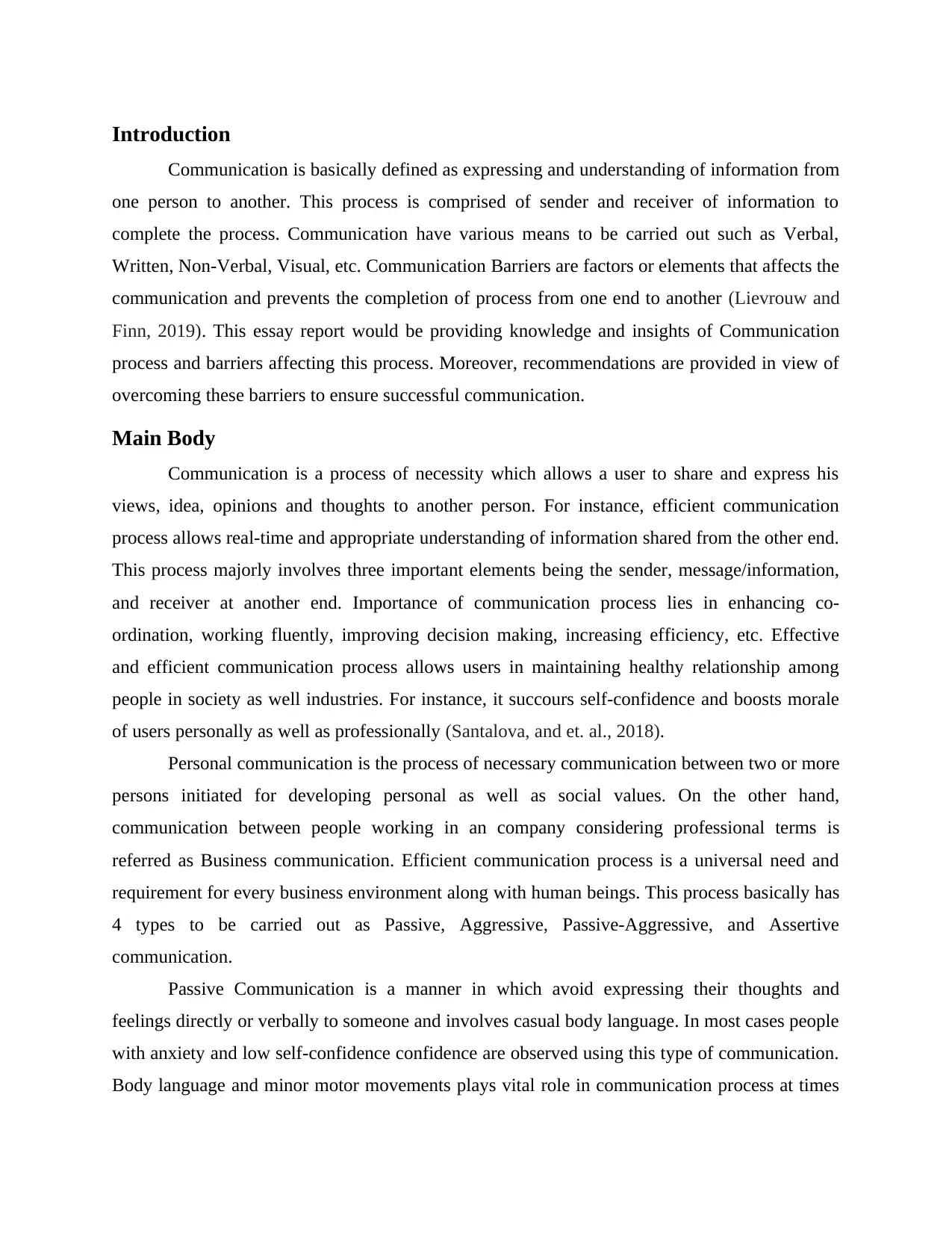
Introduction
Communication is basically defined as expressing and understanding of information from
one person to another. This process is comprised of sender and receiver of information to
complete the process. Communication have various means to be carried out such as Verbal,
Written, Non-Verbal, Visual, etc. Communication Barriers are factors or elements that affects the
communication and prevents the completion of process from one end to another (Lievrouw and
Finn, 2019). This essay report would be providing knowledge and insights of Communication
process and barriers affecting this process. Moreover, recommendations are provided in view of
overcoming these barriers to ensure successful communication.
Main Body
Communication is a process of necessity which allows a user to share and express his
views, idea, opinions and thoughts to another person. For instance, efficient communication
process allows real-time and appropriate understanding of information shared from the other end.
This process majorly involves three important elements being the sender, message/information,
and receiver at another end. Importance of communication process lies in enhancing co-
ordination, working fluently, improving decision making, increasing efficiency, etc. Effective
and efficient communication process allows users in maintaining healthy relationship among
people in society as well industries. For instance, it succours self-confidence and boosts morale
of users personally as well as professionally (Santalova, and et. al., 2018).
Personal communication is the process of necessary communication between two or more
persons initiated for developing personal as well as social values. On the other hand,
communication between people working in an company considering professional terms is
referred as Business communication. Efficient communication process is a universal need and
requirement for every business environment along with human beings. This process basically has
4 types to be carried out as Passive, Aggressive, Passive-Aggressive, and Assertive
communication.
Passive Communication is a manner in which avoid expressing their thoughts and
feelings directly or verbally to someone and involves casual body language. In most cases people
with anxiety and low self-confidence confidence are observed using this type of communication.
Body language and minor motor movements plays vital role in communication process at times
Communication is basically defined as expressing and understanding of information from
one person to another. This process is comprised of sender and receiver of information to
complete the process. Communication have various means to be carried out such as Verbal,
Written, Non-Verbal, Visual, etc. Communication Barriers are factors or elements that affects the
communication and prevents the completion of process from one end to another (Lievrouw and
Finn, 2019). This essay report would be providing knowledge and insights of Communication
process and barriers affecting this process. Moreover, recommendations are provided in view of
overcoming these barriers to ensure successful communication.
Main Body
Communication is a process of necessity which allows a user to share and express his
views, idea, opinions and thoughts to another person. For instance, efficient communication
process allows real-time and appropriate understanding of information shared from the other end.
This process majorly involves three important elements being the sender, message/information,
and receiver at another end. Importance of communication process lies in enhancing co-
ordination, working fluently, improving decision making, increasing efficiency, etc. Effective
and efficient communication process allows users in maintaining healthy relationship among
people in society as well industries. For instance, it succours self-confidence and boosts morale
of users personally as well as professionally (Santalova, and et. al., 2018).
Personal communication is the process of necessary communication between two or more
persons initiated for developing personal as well as social values. On the other hand,
communication between people working in an company considering professional terms is
referred as Business communication. Efficient communication process is a universal need and
requirement for every business environment along with human beings. This process basically has
4 types to be carried out as Passive, Aggressive, Passive-Aggressive, and Assertive
communication.
Passive Communication is a manner in which avoid expressing their thoughts and
feelings directly or verbally to someone and involves casual body language. In most cases people
with anxiety and low self-confidence confidence are observed using this type of communication.
Body language and minor motor movements plays vital role in communication process at times
⊘ This is a preview!⊘
Do you want full access?
Subscribe today to unlock all pages.

Trusted by 1+ million students worldwide
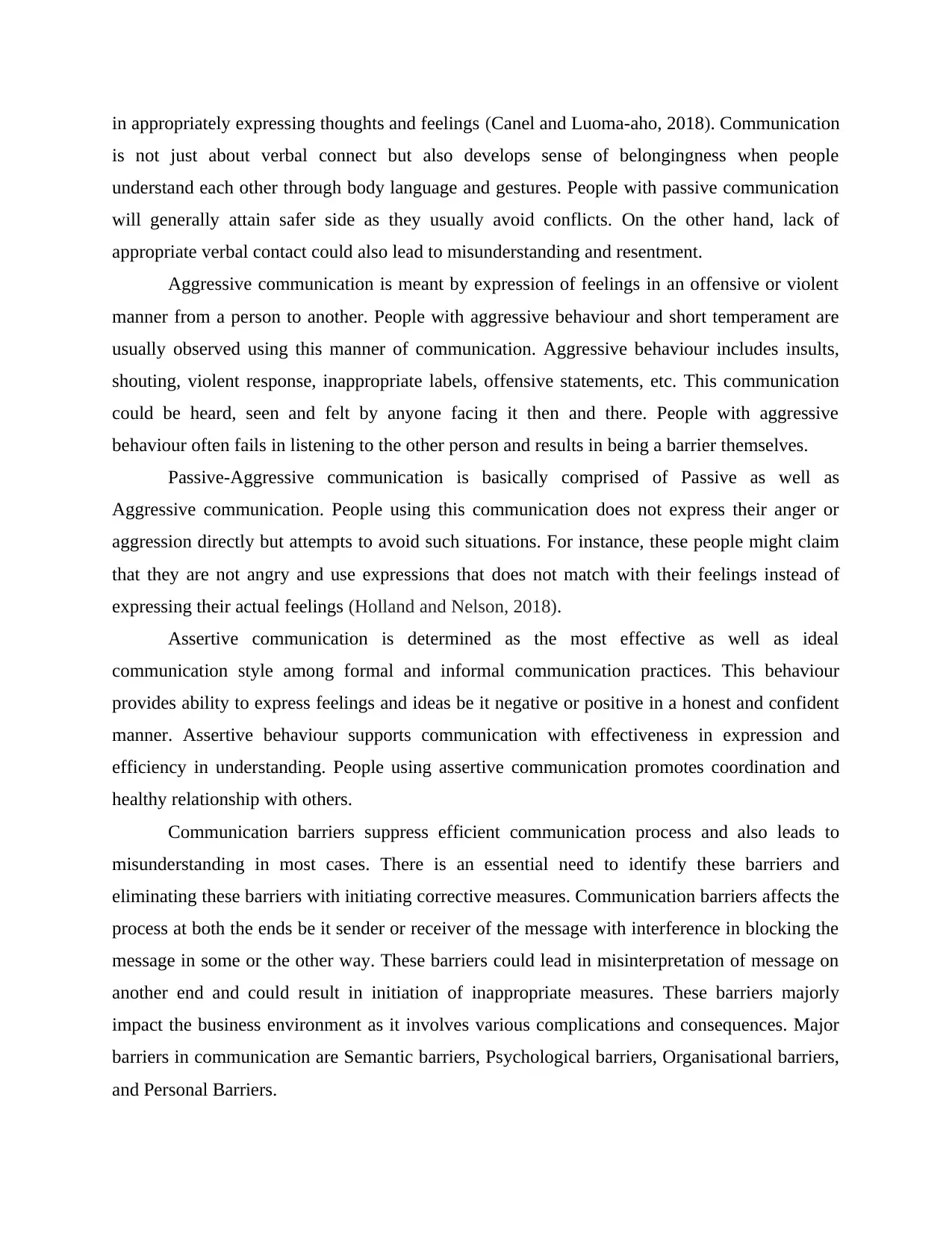
in appropriately expressing thoughts and feelings (Canel and Luoma-aho, 2018). Communication
is not just about verbal connect but also develops sense of belongingness when people
understand each other through body language and gestures. People with passive communication
will generally attain safer side as they usually avoid conflicts. On the other hand, lack of
appropriate verbal contact could also lead to misunderstanding and resentment.
Aggressive communication is meant by expression of feelings in an offensive or violent
manner from a person to another. People with aggressive behaviour and short temperament are
usually observed using this manner of communication. Aggressive behaviour includes insults,
shouting, violent response, inappropriate labels, offensive statements, etc. This communication
could be heard, seen and felt by anyone facing it then and there. People with aggressive
behaviour often fails in listening to the other person and results in being a barrier themselves.
Passive-Aggressive communication is basically comprised of Passive as well as
Aggressive communication. People using this communication does not express their anger or
aggression directly but attempts to avoid such situations. For instance, these people might claim
that they are not angry and use expressions that does not match with their feelings instead of
expressing their actual feelings (Holland and Nelson, 2018).
Assertive communication is determined as the most effective as well as ideal
communication style among formal and informal communication practices. This behaviour
provides ability to express feelings and ideas be it negative or positive in a honest and confident
manner. Assertive behaviour supports communication with effectiveness in expression and
efficiency in understanding. People using assertive communication promotes coordination and
healthy relationship with others.
Communication barriers suppress efficient communication process and also leads to
misunderstanding in most cases. There is an essential need to identify these barriers and
eliminating these barriers with initiating corrective measures. Communication barriers affects the
process at both the ends be it sender or receiver of the message with interference in blocking the
message in some or the other way. These barriers could lead in misinterpretation of message on
another end and could result in initiation of inappropriate measures. These barriers majorly
impact the business environment as it involves various complications and consequences. Major
barriers in communication are Semantic barriers, Psychological barriers, Organisational barriers,
and Personal Barriers.
is not just about verbal connect but also develops sense of belongingness when people
understand each other through body language and gestures. People with passive communication
will generally attain safer side as they usually avoid conflicts. On the other hand, lack of
appropriate verbal contact could also lead to misunderstanding and resentment.
Aggressive communication is meant by expression of feelings in an offensive or violent
manner from a person to another. People with aggressive behaviour and short temperament are
usually observed using this manner of communication. Aggressive behaviour includes insults,
shouting, violent response, inappropriate labels, offensive statements, etc. This communication
could be heard, seen and felt by anyone facing it then and there. People with aggressive
behaviour often fails in listening to the other person and results in being a barrier themselves.
Passive-Aggressive communication is basically comprised of Passive as well as
Aggressive communication. People using this communication does not express their anger or
aggression directly but attempts to avoid such situations. For instance, these people might claim
that they are not angry and use expressions that does not match with their feelings instead of
expressing their actual feelings (Holland and Nelson, 2018).
Assertive communication is determined as the most effective as well as ideal
communication style among formal and informal communication practices. This behaviour
provides ability to express feelings and ideas be it negative or positive in a honest and confident
manner. Assertive behaviour supports communication with effectiveness in expression and
efficiency in understanding. People using assertive communication promotes coordination and
healthy relationship with others.
Communication barriers suppress efficient communication process and also leads to
misunderstanding in most cases. There is an essential need to identify these barriers and
eliminating these barriers with initiating corrective measures. Communication barriers affects the
process at both the ends be it sender or receiver of the message with interference in blocking the
message in some or the other way. These barriers could lead in misinterpretation of message on
another end and could result in initiation of inappropriate measures. These barriers majorly
impact the business environment as it involves various complications and consequences. Major
barriers in communication are Semantic barriers, Psychological barriers, Organisational barriers,
and Personal Barriers.
Paraphrase This Document
Need a fresh take? Get an instant paraphrase of this document with our AI Paraphraser
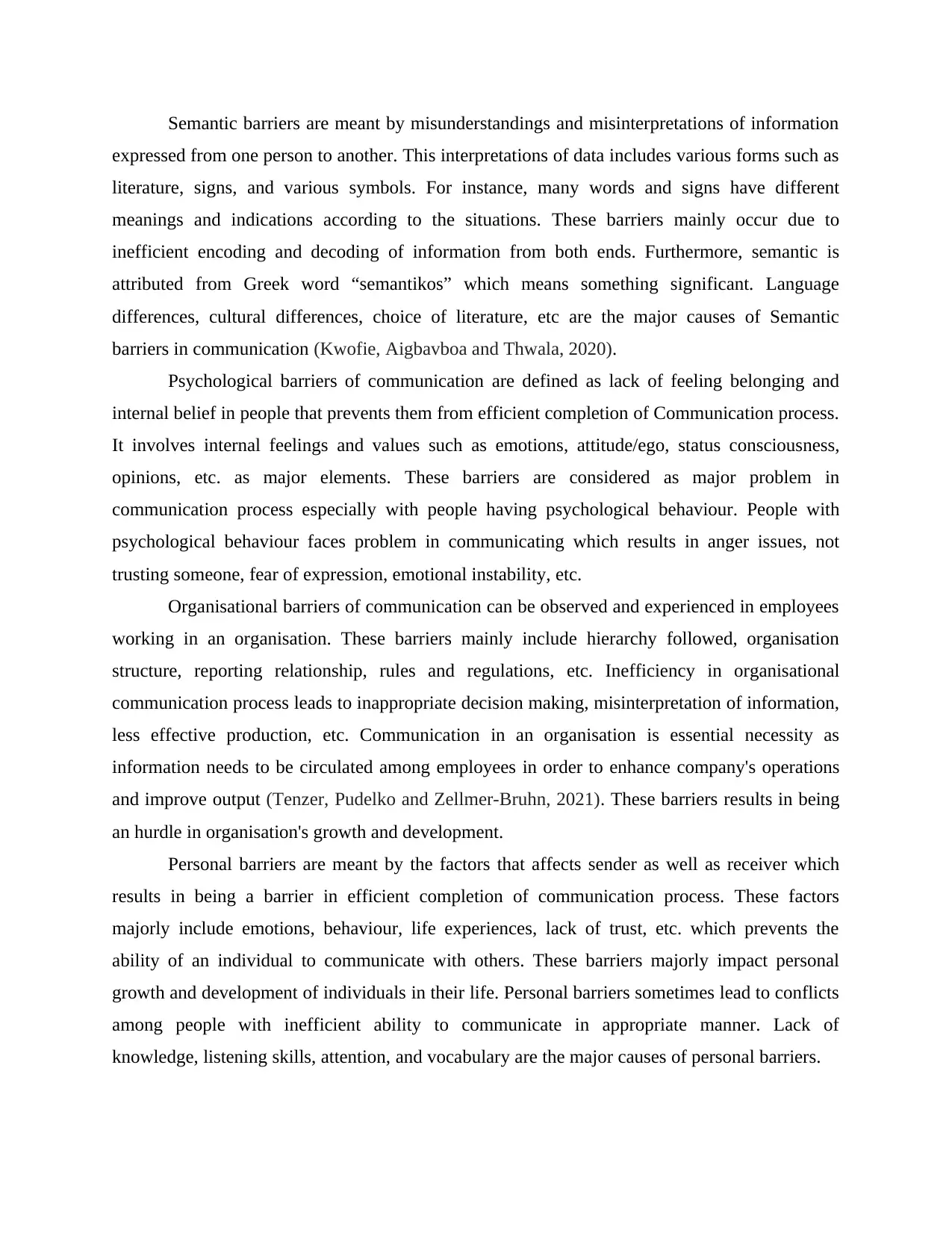
Semantic barriers are meant by misunderstandings and misinterpretations of information
expressed from one person to another. This interpretations of data includes various forms such as
literature, signs, and various symbols. For instance, many words and signs have different
meanings and indications according to the situations. These barriers mainly occur due to
inefficient encoding and decoding of information from both ends. Furthermore, semantic is
attributed from Greek word “semantikos” which means something significant. Language
differences, cultural differences, choice of literature, etc are the major causes of Semantic
barriers in communication (Kwofie, Aigbavboa and Thwala, 2020).
Psychological barriers of communication are defined as lack of feeling belonging and
internal belief in people that prevents them from efficient completion of Communication process.
It involves internal feelings and values such as emotions, attitude/ego, status consciousness,
opinions, etc. as major elements. These barriers are considered as major problem in
communication process especially with people having psychological behaviour. People with
psychological behaviour faces problem in communicating which results in anger issues, not
trusting someone, fear of expression, emotional instability, etc.
Organisational barriers of communication can be observed and experienced in employees
working in an organisation. These barriers mainly include hierarchy followed, organisation
structure, reporting relationship, rules and regulations, etc. Inefficiency in organisational
communication process leads to inappropriate decision making, misinterpretation of information,
less effective production, etc. Communication in an organisation is essential necessity as
information needs to be circulated among employees in order to enhance company's operations
and improve output (Tenzer, Pudelko and Zellmer-Bruhn, 2021). These barriers results in being
an hurdle in organisation's growth and development.
Personal barriers are meant by the factors that affects sender as well as receiver which
results in being a barrier in efficient completion of communication process. These factors
majorly include emotions, behaviour, life experiences, lack of trust, etc. which prevents the
ability of an individual to communicate with others. These barriers majorly impact personal
growth and development of individuals in their life. Personal barriers sometimes lead to conflicts
among people with inefficient ability to communicate in appropriate manner. Lack of
knowledge, listening skills, attention, and vocabulary are the major causes of personal barriers.
expressed from one person to another. This interpretations of data includes various forms such as
literature, signs, and various symbols. For instance, many words and signs have different
meanings and indications according to the situations. These barriers mainly occur due to
inefficient encoding and decoding of information from both ends. Furthermore, semantic is
attributed from Greek word “semantikos” which means something significant. Language
differences, cultural differences, choice of literature, etc are the major causes of Semantic
barriers in communication (Kwofie, Aigbavboa and Thwala, 2020).
Psychological barriers of communication are defined as lack of feeling belonging and
internal belief in people that prevents them from efficient completion of Communication process.
It involves internal feelings and values such as emotions, attitude/ego, status consciousness,
opinions, etc. as major elements. These barriers are considered as major problem in
communication process especially with people having psychological behaviour. People with
psychological behaviour faces problem in communicating which results in anger issues, not
trusting someone, fear of expression, emotional instability, etc.
Organisational barriers of communication can be observed and experienced in employees
working in an organisation. These barriers mainly include hierarchy followed, organisation
structure, reporting relationship, rules and regulations, etc. Inefficiency in organisational
communication process leads to inappropriate decision making, misinterpretation of information,
less effective production, etc. Communication in an organisation is essential necessity as
information needs to be circulated among employees in order to enhance company's operations
and improve output (Tenzer, Pudelko and Zellmer-Bruhn, 2021). These barriers results in being
an hurdle in organisation's growth and development.
Personal barriers are meant by the factors that affects sender as well as receiver which
results in being a barrier in efficient completion of communication process. These factors
majorly include emotions, behaviour, life experiences, lack of trust, etc. which prevents the
ability of an individual to communicate with others. These barriers majorly impact personal
growth and development of individuals in their life. Personal barriers sometimes lead to conflicts
among people with inefficient ability to communicate in appropriate manner. Lack of
knowledge, listening skills, attention, and vocabulary are the major causes of personal barriers.
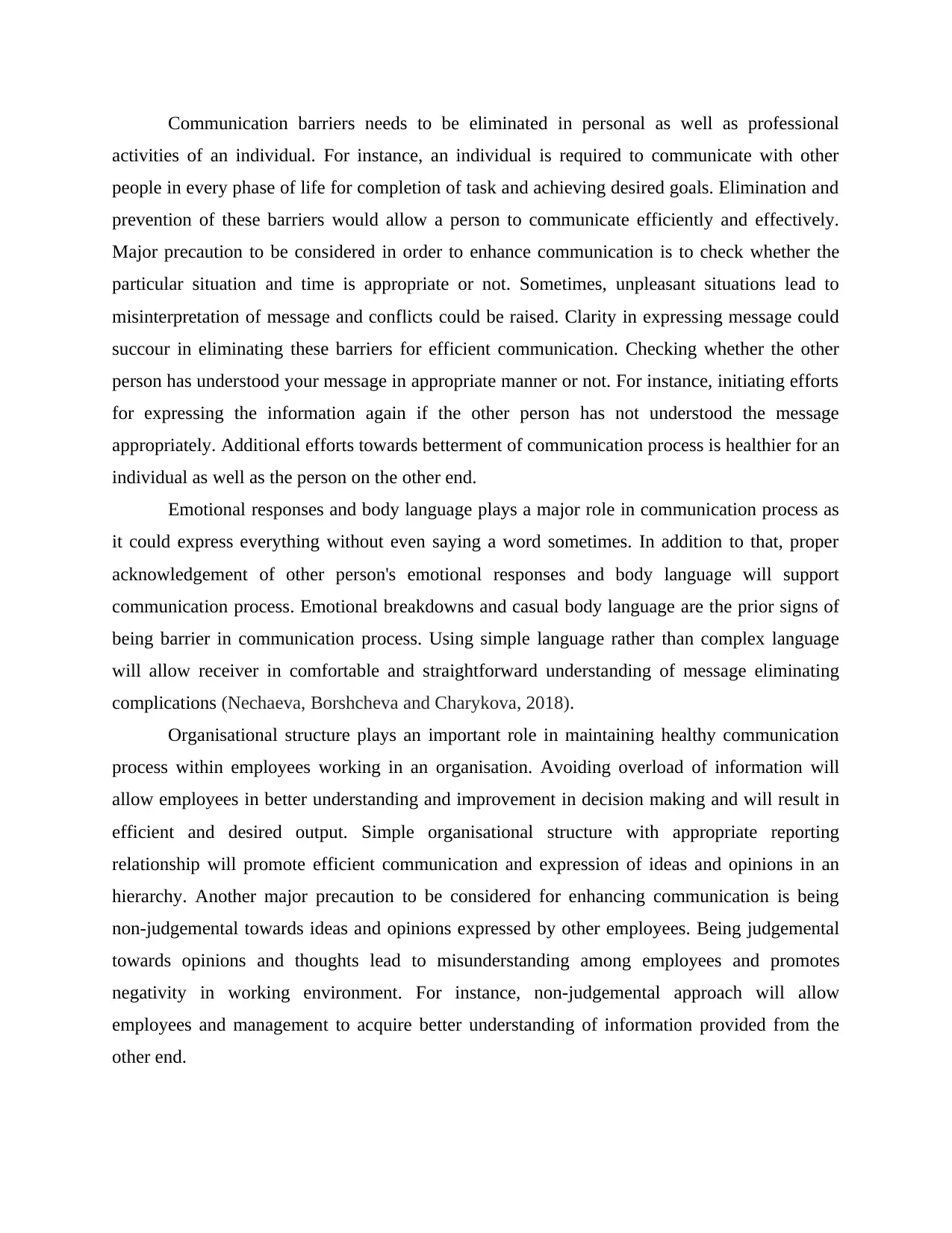
Communication barriers needs to be eliminated in personal as well as professional
activities of an individual. For instance, an individual is required to communicate with other
people in every phase of life for completion of task and achieving desired goals. Elimination and
prevention of these barriers would allow a person to communicate efficiently and effectively.
Major precaution to be considered in order to enhance communication is to check whether the
particular situation and time is appropriate or not. Sometimes, unpleasant situations lead to
misinterpretation of message and conflicts could be raised. Clarity in expressing message could
succour in eliminating these barriers for efficient communication. Checking whether the other
person has understood your message in appropriate manner or not. For instance, initiating efforts
for expressing the information again if the other person has not understood the message
appropriately. Additional efforts towards betterment of communication process is healthier for an
individual as well as the person on the other end.
Emotional responses and body language plays a major role in communication process as
it could express everything without even saying a word sometimes. In addition to that, proper
acknowledgement of other person's emotional responses and body language will support
communication process. Emotional breakdowns and casual body language are the prior signs of
being barrier in communication process. Using simple language rather than complex language
will allow receiver in comfortable and straightforward understanding of message eliminating
complications (Nechaeva, Borshcheva and Charykova, 2018).
Organisational structure plays an important role in maintaining healthy communication
process within employees working in an organisation. Avoiding overload of information will
allow employees in better understanding and improvement in decision making and will result in
efficient and desired output. Simple organisational structure with appropriate reporting
relationship will promote efficient communication and expression of ideas and opinions in an
hierarchy. Another major precaution to be considered for enhancing communication is being
non-judgemental towards ideas and opinions expressed by other employees. Being judgemental
towards opinions and thoughts lead to misunderstanding among employees and promotes
negativity in working environment. For instance, non-judgemental approach will allow
employees and management to acquire better understanding of information provided from the
other end.
activities of an individual. For instance, an individual is required to communicate with other
people in every phase of life for completion of task and achieving desired goals. Elimination and
prevention of these barriers would allow a person to communicate efficiently and effectively.
Major precaution to be considered in order to enhance communication is to check whether the
particular situation and time is appropriate or not. Sometimes, unpleasant situations lead to
misinterpretation of message and conflicts could be raised. Clarity in expressing message could
succour in eliminating these barriers for efficient communication. Checking whether the other
person has understood your message in appropriate manner or not. For instance, initiating efforts
for expressing the information again if the other person has not understood the message
appropriately. Additional efforts towards betterment of communication process is healthier for an
individual as well as the person on the other end.
Emotional responses and body language plays a major role in communication process as
it could express everything without even saying a word sometimes. In addition to that, proper
acknowledgement of other person's emotional responses and body language will support
communication process. Emotional breakdowns and casual body language are the prior signs of
being barrier in communication process. Using simple language rather than complex language
will allow receiver in comfortable and straightforward understanding of message eliminating
complications (Nechaeva, Borshcheva and Charykova, 2018).
Organisational structure plays an important role in maintaining healthy communication
process within employees working in an organisation. Avoiding overload of information will
allow employees in better understanding and improvement in decision making and will result in
efficient and desired output. Simple organisational structure with appropriate reporting
relationship will promote efficient communication and expression of ideas and opinions in an
hierarchy. Another major precaution to be considered for enhancing communication is being
non-judgemental towards ideas and opinions expressed by other employees. Being judgemental
towards opinions and thoughts lead to misunderstanding among employees and promotes
negativity in working environment. For instance, non-judgemental approach will allow
employees and management to acquire better understanding of information provided from the
other end.
⊘ This is a preview!⊘
Do you want full access?
Subscribe today to unlock all pages.

Trusted by 1+ million students worldwide
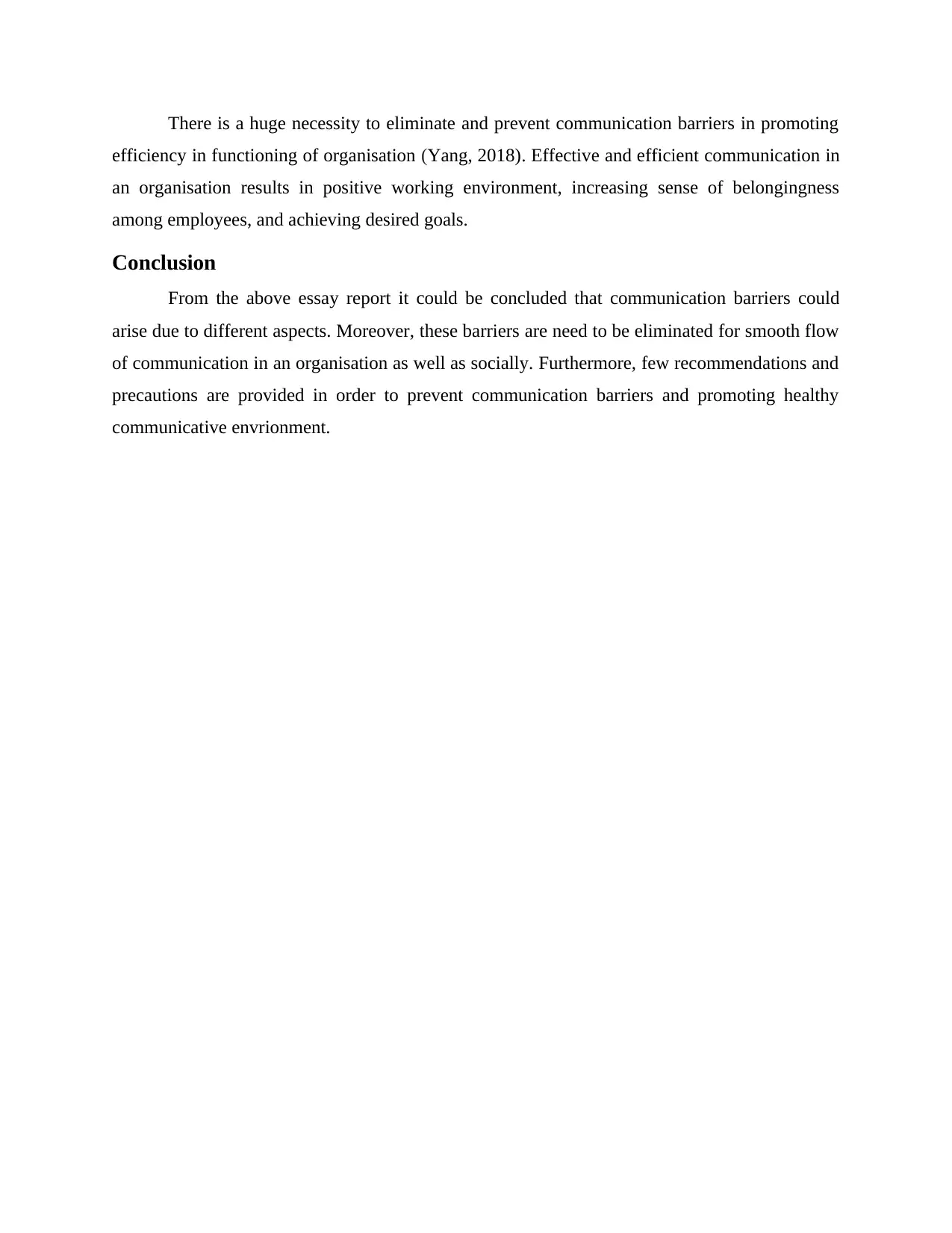
There is a huge necessity to eliminate and prevent communication barriers in promoting
efficiency in functioning of organisation (Yang, 2018). Effective and efficient communication in
an organisation results in positive working environment, increasing sense of belongingness
among employees, and achieving desired goals.
Conclusion
From the above essay report it could be concluded that communication barriers could
arise due to different aspects. Moreover, these barriers are need to be eliminated for smooth flow
of communication in an organisation as well as socially. Furthermore, few recommendations and
precautions are provided in order to prevent communication barriers and promoting healthy
communicative envrionment.
efficiency in functioning of organisation (Yang, 2018). Effective and efficient communication in
an organisation results in positive working environment, increasing sense of belongingness
among employees, and achieving desired goals.
Conclusion
From the above essay report it could be concluded that communication barriers could
arise due to different aspects. Moreover, these barriers are need to be eliminated for smooth flow
of communication in an organisation as well as socially. Furthermore, few recommendations and
precautions are provided in order to prevent communication barriers and promoting healthy
communicative envrionment.
Paraphrase This Document
Need a fresh take? Get an instant paraphrase of this document with our AI Paraphraser
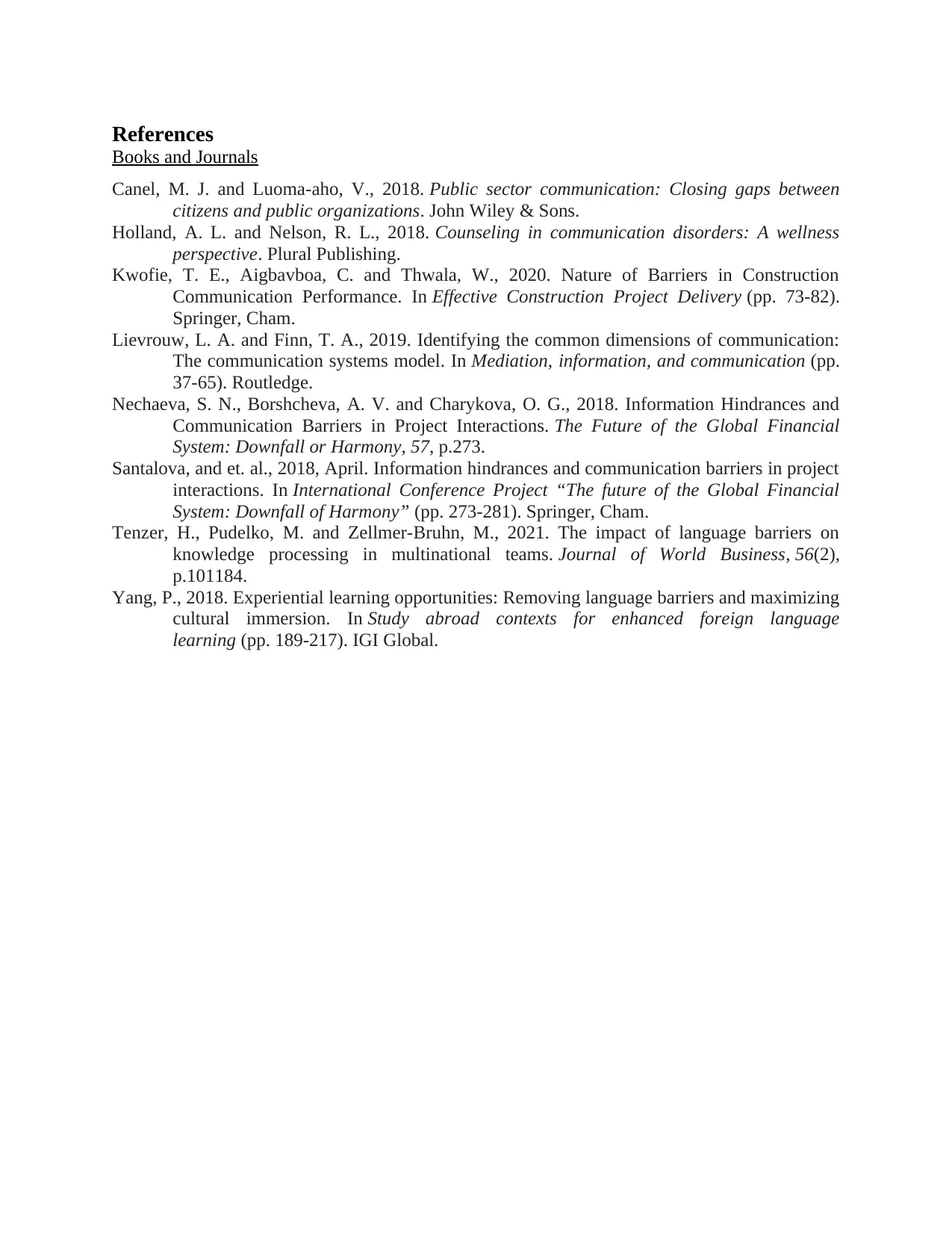
References
Books and Journals
Canel, M. J. and Luoma-aho, V., 2018. Public sector communication: Closing gaps between
citizens and public organizations. John Wiley & Sons.
Holland, A. L. and Nelson, R. L., 2018. Counseling in communication disorders: A wellness
perspective. Plural Publishing.
Kwofie, T. E., Aigbavboa, C. and Thwala, W., 2020. Nature of Barriers in Construction
Communication Performance. In Effective Construction Project Delivery (pp. 73-82).
Springer, Cham.
Lievrouw, L. A. and Finn, T. A., 2019. Identifying the common dimensions of communication:
The communication systems model. In Mediation, information, and communication (pp.
37-65). Routledge.
Nechaeva, S. N., Borshcheva, A. V. and Charykova, O. G., 2018. Information Hindrances and
Communication Barriers in Project Interactions. The Future of the Global Financial
System: Downfall or Harmony, 57, p.273.
Santalova, and et. al., 2018, April. Information hindrances and communication barriers in project
interactions. In International Conference Project “The future of the Global Financial
System: Downfall of Harmony” (pp. 273-281). Springer, Cham.
Tenzer, H., Pudelko, M. and Zellmer-Bruhn, M., 2021. The impact of language barriers on
knowledge processing in multinational teams. Journal of World Business, 56(2),
p.101184.
Yang, P., 2018. Experiential learning opportunities: Removing language barriers and maximizing
cultural immersion. In Study abroad contexts for enhanced foreign language
learning (pp. 189-217). IGI Global.
Books and Journals
Canel, M. J. and Luoma-aho, V., 2018. Public sector communication: Closing gaps between
citizens and public organizations. John Wiley & Sons.
Holland, A. L. and Nelson, R. L., 2018. Counseling in communication disorders: A wellness
perspective. Plural Publishing.
Kwofie, T. E., Aigbavboa, C. and Thwala, W., 2020. Nature of Barriers in Construction
Communication Performance. In Effective Construction Project Delivery (pp. 73-82).
Springer, Cham.
Lievrouw, L. A. and Finn, T. A., 2019. Identifying the common dimensions of communication:
The communication systems model. In Mediation, information, and communication (pp.
37-65). Routledge.
Nechaeva, S. N., Borshcheva, A. V. and Charykova, O. G., 2018. Information Hindrances and
Communication Barriers in Project Interactions. The Future of the Global Financial
System: Downfall or Harmony, 57, p.273.
Santalova, and et. al., 2018, April. Information hindrances and communication barriers in project
interactions. In International Conference Project “The future of the Global Financial
System: Downfall of Harmony” (pp. 273-281). Springer, Cham.
Tenzer, H., Pudelko, M. and Zellmer-Bruhn, M., 2021. The impact of language barriers on
knowledge processing in multinational teams. Journal of World Business, 56(2),
p.101184.
Yang, P., 2018. Experiential learning opportunities: Removing language barriers and maximizing
cultural immersion. In Study abroad contexts for enhanced foreign language
learning (pp. 189-217). IGI Global.
1 out of 8
Related Documents
Your All-in-One AI-Powered Toolkit for Academic Success.
+13062052269
info@desklib.com
Available 24*7 on WhatsApp / Email
![[object Object]](/_next/static/media/star-bottom.7253800d.svg)
Unlock your academic potential
Copyright © 2020–2025 A2Z Services. All Rights Reserved. Developed and managed by ZUCOL.





